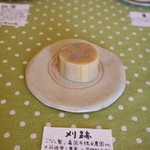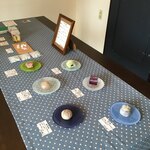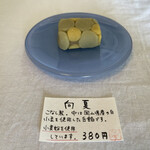
和菓子店 青洋
wagashimiseseiyou ◆ ワガシミセセイヨウ
3.61
Takaragaike, Kitayama
「Japanese Sweets」
--
--
Opening hours: Open 3 days a month (relatively often on the third Friday, Saturday and Sunday) 11:00-18:00 *Sales days are announced on the website on a case-by-case basis.
Rest time: Open irregular hours and closed days are subject to change, so please check with the store before visiting.
京都府京都市北区紫竹西野山町54-1
Photos
(20)




















Details
Awards
Reservation Info
can be reserved
Payment Method
No credit cards
Electronic money is not accepted
Private Dining Rooms
None
Smoking and Non-Smoking
No smoking at the table
Parking
None
Comments
(19)
ゆっきょし
4.00
First Visit 202307 (No.4707)
1. Purpose of Visit
- Selected as the 3rd shop for the 3rd day of Kyoto trip
2. Shop Information
- Genre on Tabelog: Japanese sweets
- Opened in March 2012
- Aoyama Yoko, who trained for 10 years at Yushikashi Gocho Shinjo "Ryomatsu", opened her own studio
- Selected as one of the Top 100 Sweet Shops in the West on Tabelog in 2018
- Business Hours: Open 3-4 days a month (Fridays, Saturdays, and Sundays at the end of the month are relatively common) 11:00-18:00
- Takeout only ⚠️ Sales dates are announced on the website around the 10th of each month
3. Crowdedness on the Day
- Visited at 11:02 on a weekday with 1 customer ahead and 1 customer behind
4. Customer Service
- Standard response as per the manual
5. Purchased Items
- "In Search of Shade" 420 yen
- "Sanpu" 440 yen
- "Summer Peak" 420 yen
- "Seisumi" 450 yen
6. Summary
This shop mainly deals with made-to-order Japanese sweets, but occasionally they sell special sweets at the studio for promotional purposes on a few days of the month. I took this opportunity to purchase the above 4 items. They were delicious wagashi with unique combinations of ingredients that you don't see elsewhere. If you enjoy Japanese sweets, this is a shop worth visiting. Thank you for the meal.




OGポーギー
3.90
I enjoyed delicious Japanese sweets again this time. The fragrant "Haru Kizasu" (made from sweet bean paste) and the elegant sweetness of "Issei ni" with a pleasant pistachio aroma were both delicious. Thank you for the meal. I have been thinking recently that it might be important to buy a plate specifically for Japanese sweets when enjoying them.




OGポーギー
3.80
I received two beautiful wagashi, "Hyoke" made of gyuhi and "Haru wo Tobu" in the shape of a rabbit. Both were elaborate in appearance and taste, and as a wagashi lover, I was very satisfied. The combination of wagashi and flowers displayed in front of the store looked very beautiful. Please excuse the wrinkled paper wrapping the sweets.


OGポーギー
3.90
This is my third visit to this shop. The beautiful sweets and perfect level of sweetness suit me very well, making it my favorite shop. Today, during the Christmas season, I splurged a bit and bought all six items. Each sweet was beautiful and delicious, with flavors I had never tasted before.




OGポーギー
4.10
I had been interested in this shop for a while. Luckily, this month there was some sort of exhibition at the end of the month, so I was able to go early. I arrived just in time, and the staff greeted me with a smile. In front of the shop, there were beautifully displayed sample products to choose from. There were about six different types of sweets, all of them looking like works of art. I chose "Autumn Deepens," "Flowing," and "Cotton Burst." When I got home, I brewed some tea and started a delightful tea party. First, I tried "Autumn Deepens." The sweetness of the chestnut was surprising and delicious, spreading the taste of autumn in my mouth. I'm not a big fan of chestnuts, but this one was really tasty, made with delicious chestnuts from Kyoto. Next was "Flowing." At first, I wasn't sure what kind of sweet it was, but after one bite, I knew it was pear! The cool and refreshing appearance of the mochi, wrapped with pear and white bean paste, was delightful. The sweetness of the pear was elegant and almost too good to eat. White bean paste really goes well with fruits. Lastly, "Cotton Burst." The light and fluffy dough wrapped around the sweet bean paste, with nuts adding a unique touch. The fluffy dough and the subtly sweet bean paste harmonized perfectly, emphasizing the natural flavors of the ingredients. Traditional Japanese sweets that don't rely solely on sweetness but bring out the true flavors of the ingredients. I love them.


紫陽花の朝
4.10
On Christmas Eve 2021, I decided to go with a "Japanese" theme as Aoyama-san had just opened. We enjoyed 6 different types of traditional Japanese sweets: Fuyuhi (skewered sweet potato and chestnut), Nami Nami (sweet rice cake), Mizuhana (white chocolate yokan), Yukifuru Yoru (steamed bun), Kokoro Odoru (rice cracker), and Eiju (baked mochi). Each sweet had its own unique flavor, color, and story. We savored them while watching TV, sipping tea, and relaxing by the kotatsu. It was a special treat for just the two of us, and a delightful way to enjoy a Japanese-style Christmas.




けいちゃん39960
3.80
I visited a shop that is only open for 4 days within a month because I really wanted to try their sweets. I made a reservation in advance through their website. The shop creates seasonal Japanese sweets with unique designs. The sweets I tried today were delicious and you could really feel the thoughtfulness of the shop owner in each one. The taste was amazing, with a deep sweetness, aroma, and lingering aftertaste. The sweets were also incredibly beautiful. I would love to try their summer sweets next time. Thank you for the wonderful experience.




comotan
3.90
I visited a popular Japanese confectionery shop in the northern part of Kyoto today. The shop, called Seiyo, is run by a owner who trained at "Yushokukashi Gocho Shinjo Roshou" and has been selected as one of the top 100 sweets shops in the Sweets WEST in 2018 according to Tabelog. The shop offers a variety of unique Japanese sweets, with prices starting at 380 yen each. I purchased two sweets: one with a pattern resembling a wedding dress and another shaped like a camellia flower. Both were delicious and had a creamy texture, with one surprise ingredient being cream cheese. The shop is a bit far, but definitely worth a visit if you're in the area.




干瓢巻き星人
4.00
In October, this traditional Japanese sweets shop offers six items: Asa Samusa, Oto To To, Akikaze, Akishou, Choumei, and Akishou. They are only available for sale four days a month. You can also place orders through their website.



S.Y Nのグルメ日記
3.60
Located a 25-30 minute walk from Kitaoji Station, there is a popular traditional Japanese sweets shop called Seiyo that offers seasonal Japanese sweets. It was selected as one of the top 100 sweets shops in 2018. The shop is only open three times a month, so it's recommended to check their website for the opening days before visiting. This time, I bought their popular Kiwi Yokan. This refreshing yokan, which combines Japanese and Western elements, has a nice balance of the tartness of kiwi and the sweetness of water yokan, leaving a lasting impression as a specialty sweet from Kyoto! Although the shop is quite difficult to get to, if you ever find yourself in the Kitaoji area, be sure to pay a visit. Bon appétit!

cornk
4.10
Visited on Saturday afternoon by bicycle for the second time. This place is only open three days a month. Purchased two types of wagashi. "Autumn Harvest" for 350 yen: Made with tsukune-imo and filled with red bean paste from Hokkaido. "Frontline of Autumn Leaves" for 350 yen: Made with konashi and filled with white bean paste from Okayama. The sweets were delicious and had a charming taste.




yuyuyu0147
4.00
In Murasakino Sendouchou, Kyoto, there is a traditional Japanese confectionery shop called Wagashi Mise Seiyo. The shop is run by Aoyama Yoko, who trained for 10 years at Aramaki Gochoshinjo Rosho. She opened her shop in March 2012 with the desire to share the beauty, creativity, deliciousness, and potential of traditional Japanese confectionery with many people. The shop is only open for sales three days a month, but they also take custom orders for wagashi and hold wagashi making classes.
During my visit last month, I tried the January wagashi selection:
- Shizuku (400 yen): A creation symbolizing new beginnings with a delicate and beautiful design. Made with sweet potato and red bean paste.
- Hyoryu (400 yen): A winter-themed jelly dessert made with agar and soy milk, featuring a unique texture using pesticide-free cabbage.
- Kigan (350 yen): A soft steamed bun filled with smooth and mildly sweet red bean paste.
- Fudaasobi (400 yen): A colorful and artistic dessert made with white bean paste, organic eggs, walnuts, almonds, and wheat from specific producers.
- Yukimamire (350 yen): A cute snow-themed wagashi made with white bean paste from Okayama and a traditional Kyoto confectionery technique.
- Mairu (350 yen): A mochi confection with a tofu-like filling made with fried tofu and wrapped in mochi made from glutinous rice flour.
The unique and delicious wagashi creations at Wagashi Mise Seiyo offer a glimpse into the world of traditional Japanese confectionery. Don't miss the opportunity to try these exquisite treats when the shop is open on February 15-17 and March 22-24.




カフェモカ男
3.80
Located a 5-minute walk from the Shino Izumido-cho bus stop, near the Kitaoji Bus Terminal in Kyoto, is "Seiyo" (青洋). Established by Yoko Aoyama, who trained for 10 years at the prestigious Gochoshinjo Shinsho Rojo, this quaint shop opened its doors in March 2012. They sell traditional Japanese sweets at their workshop only three days a month, serving as both a shop and a promotional space. I visited in October, where the shop's charming red roof and white walls welcomed me. Inside, a small selection of wagashi (Japanese sweets) was neatly displayed on tables, each accompanied by a brief description. I purchased all six varieties available that month: "Sour Melody," "Autumn Light Stripes," "Twin Beaches," "Autumn Festival," "Smooth," and "Harvest Tracks." The wagashi were all delicately colored and beautifully presented. Not only were they visually appealing, but they were also incredibly delicious. In particular, the "Sour Melody" was a standout with its subtle and refined taste, made from sweet potato and chestnut. Highly recommended.




cornk
4.10
Visited for the first time on a Saturday afternoon. The shop is only open 3 days a month. It's far from the station. Very rare and valuable. Since I don't know when I'll be able to visit again, I bought one of each item. There are 6 types of wagashi: Sanso 350 yen, Akikoujima 350 yen, Soubi 400 yen, Akimatsuri 400 yen, Sarari 350 yen, Kariato 400 yen, and Akigeshiki (dried sweets) 300 yen. The wagashi have a delicate design with light colors. Kariato is a chestnut sweet with a subtle sweetness. Akimatsuri is like a sponge cake-style wagashi. The others will be enjoyed by my family. I was able to enjoy very delicious and rare wagashi.




sweetsFC
0.00
"Hmm, after reading the description, it seems like they're trying to be bold but it's not really hitting the mark..."
"Yeah, it's not like it's based on a classic or simple selling point..."
"However, it feels like they put in a lot of effort to end up with something that tastes like a cheap snack you'd find at the back of a drugstore, not much more than that..."




OGポーギー
4.10
I was impressed by the beautiful sweets that evoke the arrival of spring. Among them, "Koinotsu" not only has the sweetness and fragrance of strawberries, but also a gentle texture and sound, as well as its beauty that can be enjoyed with all five senses. I also enjoyed the other sweets. Thank you for the meal.


maru-181
3.30
A small space selling delicate and beautiful traditional Japanese sweets. The limited monthly sales allow for a relaxed atmosphere where you can chat with the staff and choose your favorite sweets up close. It's a delightful experience.


ガチ暇人
4.50




misoshoyu
0.00

Email Login